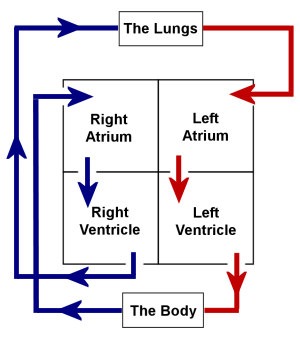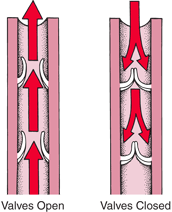HOW DOES THE HEART WORK?
A lot of people are confused about the heart and all its veins and arteries. What even are veins and arteries? Hopefully, this post will help you understand all this better.
THE HEART AND IT'S CHAMBERS
The heart has 4 chambers with different functions. To visualise this let’s get a diagram.

The 2 chambers at the top are the left and right atria (atriums) and the ones at the bottom are the left and right ventricles. These chambers have different purposes that all need going through so expect this to be a long post. The artia basically serve as a place for the blood to arrive, the way a lobby acts as an entrance to a building. The ventricles have the more tricky job of pumping the blood a heck of a long way to wherever it needs to go. This is why they are nice and muscular.
ATRIUM? VENTRICLE?
Yep! The diagram below is an easy way to visualise the way the blood flows; from where to where. Below is a sort of narrative of where the blood goes on this journey. I find writing a little narrative quite useful to get the idea of what is going on.

After traveling around the body, the blood has a very low oxygen content and is being pumped back to the heart through the Vena Cava to get some oxygen. It is pumped from the right atrium into the right ventricle through the tricuspid valve. The right ventricle then pumps it to the lungs through the Pulmonary artery. At the lungs, the blood offloads it’s carbon dioxide and takes some oxygen. It is then pumped back to the heart in the Pulmonary vein. It arrives in the left atrium and it pumped through the bicuspid valve into the left ventricle. The left ventricle then gives the blood a mighty squeeze (use contract or contraction for marks), forcing through the semi-lunar valve at a very high pressure into the Aorta and around the body.
This explains why the left side of the heart is larger, it is more muscular because it needs to pump blood all around the body whereas the right side only needs to pump it to the lungs.
VEINS? ARTERIES? CAPILLARIES? WHAT'S THE DIFFERENCE?
Arteries carry blood away from the heart and veins carry blood to the heart. Arteries have much thicker muscular walls, as blood it pumped through them at a very high pressure and hey need to be able to withstand this. Veins have much thinner walls as they don’t need to withstand such a high pressure. Veins also have valves so there is no backflow of blood. This also helps blood get back to the heart from places like the legs, where it isn’t so easy to flow uphill. The diagrams below show all you need to know about these valves.


Looking at the syllabus for Edexcel, it looks like this is about all I need to cover. If not, comment down below and I’ll add to this.